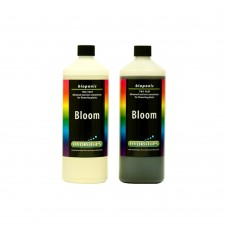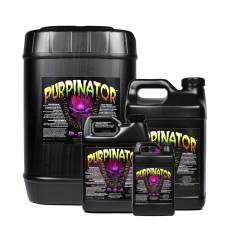Using Purpinator alongside your regular feeding regimen will help to bring out the flavours and aromas of your plants by greatly increasing the concentration of terpenes, just like Terpinator does. Terpenes (and other secondary metabolites) are major components of the essential oils of various species of flowers and plants. They are molecular compounds made up of repeating isoprene structures and they're also what give plants their distinctive aromas. Stronger smelling and tasting crops are assured.
On top of giving you all the benefits of Terpinator, Purpinator also activates certain intra-cellular bio-chemical processes which bring out purple hues and colouration in plants with the genetic potential to do so. Certain types of cells in plants are responsible for producing compounds called flavonoids which are basically antioxidants. Purple coloration is caused by a mixture of both red and blue pigments. The plant produces more of them under certain conditions such as when they are under the stress of cold conditions. Purpinator creates the right conditions in the cells and vacuoles to increase production of these purple flavonoids, even when they are not under stress. It does this by making the pH inside these cells (and the plant sap) more neutral.
One particular group of flavonoids are called anthocyanins and it is these particular flavonoids that have a purple colour, especially one called Cyanidin. When Purpinator is given to a plant which has the ability to produce Anthocyanins then production of them is increased markedly, bringing out the highly attractive, and sought after, purple colourations. Customer reviews and testing are showing that this is a very effective product. If plant sap pH is low then Cyanidin tends to be red, When the plant sap has a high pH it tends to be more blue. The neutral sap pH that Purpinator encourages helps to bring out both colours which when combined produce purple hues.
Please remember that not all strains or cultivars, and sometimes not all individual plants within a particular strain will have the genetic ability to produce large quantities of anthocyanins. For these strains and individual plants, Purpinator will NOT be able to bring out purple colouration. However, for those plants that can produce anthocyanins, Purpinator will go a long way to promote the maximum purple colouration potential. It is also worth knowing that the inclusion of some blue light (400nm-500nm) likewise stimulates the production of purple pigments. This is the action spectra for anthocyanin pigment synthesis. Likewise, cooler night temperatures will aid in the production of violet tints in leaves, fruits and flowers.
Rigorous manufacturer's testing and customer reviews indicate that this is a very effective product.
- Maximises terpene levels within the plant
- Promotes intense aromas, even after drying
- Drastically improves the flavours of fruits and scents of flowers
- Formulated from natural ingredients
- Stimulates essential oil production
- Brings out the purple hues in plants which have the genetic tendency to do so
- Increases the display appeal of the finished product
- Add some blue light (400-500nm) during flowering/fruiting for maximum effect
- Can be used alongside any brand of nutrients
- Highly effective in all types of media
- Formulated to have little to no effect on EC levels (dissolved mineral content)
- There's no need to modify the grow environment for Purpinator to work
Using Purpinator :
Purpinator can be used for plants grown in any substrate be it soil, coco or clay pebbles. Do not use with Terpinator as this unneccessary and could lead to overdosing.Purpinator is highly concentrated. Shake well before use, particularly if crystals appear in the bottle. If adding it to a reservoir then make sure it is well aerated, especially in DWC.
Purpinator can be used throughout both the vegetative and flowering stages, though it is particularly effective to use it during the flowering stage, especially during the mid to late stages.
In order to maximise the effectiveness of Purpinator, add some blue light in the wavelength range of 400-500nm which is known to be the action spectra for anthocyanin production.
Never mix nutrients and boosters together in their concentrated form (i.e. straight out of the bottle). As with all nutrients and boosters, add each of them to your feed water one at a time, giving the solution a good stir to mix it in before adding the next one.
Veg: 0.5ml – 1.0ml per litre of nutrient solution
Early to Mid Flower: 1.0ml – 3.0ml per litre of nutrient solution
Late Flower (last 2-3 weeks): 5.0ml - 8.0ml per litre of nutrient solution
Purpinator NPK: 0-2-4
-
Your shopping cart is empty!










